
“My


“My
Page 8
What discord reveals about our denomination JUSTIN KIM
What time does Sabbath start and end? Our answer in 1851 was 6:00 p.m. 1 It wasn’t until 1855 that J. N. Andrews concluded from his studies that each day in Genesis 1 began at sunset. 2 After all, the Hebrew ‘ erev for “evening” meant sunset itself.
Discord arose. Then at a conference Andrews presented his Bible study. Convicted, attendees voted sunset as the Sabbath limits. Four days later Ellen White received confirmation in a vision. Conversing with an angel, she inquired why the misunderstanding had occurred:

Some lessons emerge:
1. Our identity, mission, and practice are founded upon Scripture. Issues were settled through Bible study and confirmed by vision, not the other way around.
2. God is displeased when we choose disobedience after being confronted with truth. It is a sin to reject light.
3. Truth progressively builds upon previous light, namely Scripture. Andrews later wrote two more books on the Sabbath.
4. Unity and truth are interwoven. We must draw together and press together.
Our identity, mission, and practice are founded upon Scripture. Issues were settled through Bible study and confirmed by vision, not the other way around.
“Said the angel: ‘If light come, and that light is set aside or rejected, then comes condemnation and the frown of God; but before the light comes, there is no sin, for there is no light for them to reject.’ I saw that it was in the minds of some that the Lord had shown that the Sabbath commenced at six o’clock, when I had only seen that it commenced at ‘even,’ and it was inferred that even was at six. I saw that the servants of God must draw together, press together.”3
As the Sabbath will be a testing truth in the last days,4 let us remember the lessons of our history: keep God’s Word dear to our hearts, mind the warnings of the Spirit of Prophecy, and keep the Sabbath holy from sunset to sunset.
1 In Review and Herald, Apr. 21, 1851.
2 In Review and Herald, Dec. 4, 1855.
3 Ellen G. White, Testimonies for the Church (Mountain View, Calif.: Pacific Press Pub. Assn., 1948), vol. 1, p. 116.
4 Ellen G. White, The Great Controversy (Mountain View, Calif.: Pacific Press Pub. Assn., 1911), p. 605.
Adventist College Palawan opens with degrees in theology, education, and social work.
Melo Anadem Ong,
Seventh-day Adventist leaders, guests, and other stakeholders participated in the dedication and inauguration of Adventist College Palawan (ACP) in the Philippines on August 2-3. They celebrated a long-awaited breakthrough in Adventist education 58 years after the elementary school was first established.
The ceremony gathered representatives from the Commission on Higher Education (CHED), Department of Education (DepEd), Philippine National Police, barangay—or town—officials and officers from mission fields, and representatives from sister colleges, universities, and other institutions. Former faculty, staff, and alumni were also present.
ACP’s journey was decades in the making. The dream of becoming a college took a decisive turn in January 2023, when the former North Philippine Union Conference (now Northern Luzon Philippine Union Mission) formally approved the upgrade of Palawan Adventist Academy (PAA) to ACP. This was followed by the groundbreaking ceremony in April 2023. In February 2025 the International Board of Education conducted a formal evaluation for the proposed institution. Yet the vision itself dated much further back—to 1967, when PAA first opened its doors with just 109 students.
ACP is opening with three initial courses: Bachelor of Arts in Theology,
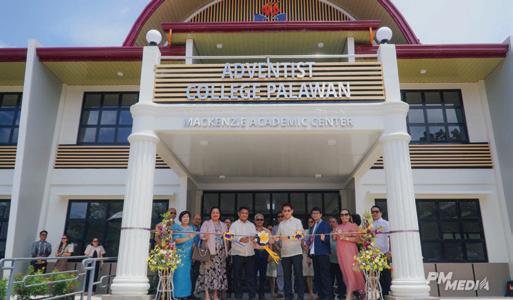
Bachelor of Early Childhood Education, and Bachelor of Science in Social Work. The campus spans 56 hectares (138 acres) in Tacras, Narra, in the southern part of Palawan.
Words From the Leaders
During the Sabbath worship, Gerardo Cajobe, president of the Southern Luzon Philippine Union Mission, reminded the congregation of the higher calling of Adventist education. “The reason our institutions exist is simple— to bring people to God,” he said.
“WHAT BEGAN AS A DREAM DECADES AGO HAS NOW BEEN FULFILLED.”
Cajobe emphasized that ACP’s progress is a clear display of God’s hand moving through His people. “God acts—He moves to fulfill His purposes through leaders and educators who dared to dream, through donors and workers who gave selflessly, and through members who believed even when all they had was a burden. God cares—He sustains what He begins. And God plans—He educates for eternity.”
Mary Jane Zabat, newly elected Southern-Asia Pacific Division Education director, also reflected on the account of building the tabernacle. She urged that ACP’s development must always follow
God’s blueprint. “The inauguration is a recognition of God’s acceptance and abiding presence. God wants to dwell in ACP at all times,” she said.
ACP has undertaken major developments to meet the needs of its growing student population and expanding academic programs. These include the construction of 16 new classrooms, the renovation of the cafeteria, the addition of two duplex housing units for faculty and staff, a new auditorium and library, and the completion of the Educational Center, which houses the offices and additional classrooms.
Ongoing and planned projects also include dormitories for men and women, a gymnasium, a campus church, concrete roadways, a clinic, and a food factory. In keeping with its vision for continuous growth, ACP also plans to introduce two new degree programs each year, school leaders said.
During the celebration sister institutions and Adventist offices brought their financial gifts to support the college’s mission. The Adventist Hospital Palawan likewise pledged to sponsor three students—one for each of the initial programs.
“What began as a dream decades ago has now been fulfilled,” church leaders said. “ACP now stands not only as a new institution of higher learning but also as a living testimony of what God can do through concerted efforts and sacrificial giving.”
A moment of conviction leads Lebelis Nazar to a public decision.
While thousands across Colombia marked independence day on July 20 with cultural celebrations, nearly 2,000 Adventist youth in northern Colombia took to the streets with uniforms, smiles, and messages of hope.
Amid the nationwide celebrations, the Seventh-day Adventist Church mobilized its youth clubs across northern Colombia. Among the many onlookers, one young girl was so deeply moved by the march that she made a life-changing decision: to give her life to Christ through baptism.
“I got so emotional. I felt like I was supposed to be there—that it was my place,” said 15-year-old Lebelis Nazar, who had been drawing closer to God for several months and had shown interest in the Pathfinder Club she was attending. “I just needed a little encouragement, and when I saw the march, it felt as though God was calling me directly.”
After speaking with her mother—who expressed support despite not being an Adventist—Nazar, accompanied by her club leader and some friends, arrived at the local church, where she was baptized by Edilberto Ospina, from the Guaranda district, at the end of the activity.
“She cried when she came out of the water. We all cried,” said Yoelis Yepes, club director. “This ministry has become a refuge. Here young people find direction, purpose, and the love of Christ.”

The Jadá Club, to which Nazar belongs, is part of the Caribbean Colombian Conference (CCC), a region in which Youth Ministries have seen notable growth, local church leaders said. Comprised mostly of young people from non-Adventist homes, the club has ignited a spiritual flame that continues to draw teenagers to the feet of Jesus, youth leaders said.
“Our method is Christ’s method: we serve first, then we evangelize—and it’s bearing fruit,” said Yaith Echeverría, district youth leader.
This is not an isolated case.
“THIS MINISTRY HAS BECOME A REFUGE. HERE YOUNG PEOPLE FIND DIRECTION, PURPOSE, AND THE LOVE OF CHRIST.”
“Since 2018, in the city of Cartagena—where the headquarters of our conference is—the Adventist Church has been officially invited to participate in the national independence day parade on July 20, representing the Cartagena Adventist School (CAC). The parade includes educational institutions, the national police, and military forces,” said Bruno Villegas, Youth Ministries director of CCC.
In Saravena, a town in the eastern department of Arauca, independence day also became a deeply mission-focused occasion. There, the Seventh-day Adventist Church is invited each year because of its positive community impact.
This year, all three youth clubs—Adventurers, Pathfinders, and Master Guides— from the five local districts took part in the parade, accompanied by the marching band from Bethel Adventist School. More than 150 youth not only participated in the parade but also distributed missionary literature to passersby and took part in patriotic ceremonies.
“The leadership exercised by the North Colombian Union over local fields is not just about organizing events and expecting support,” said Mauricio Buitrago, Youth Ministries director of the North Colombian Union Conference. “It’s about empowering local fields to work through what they already have—engaging in service and witness,” he said.
“Lebelis’s baptism is proof that today’s youth are making thoughtful, spiritually grounded decisions,” added Edilberto Ospina, district pastor in Guaranda. “It reflects the work being done by the clubs, how they’re impacting society and leading young people to make wise choices in a broken world. We praise God for it.”
“The
nationwide release marks a significant moment for the church’s mission through media. It’s exciting to see the church reaching such a high level in the film world with The Hopeful. In times like these, we hope it will spark meaningful conversations about the value of living with faith in God.”
—Abel Márquez, executive director of Hope Channel Inter-America, about the premier of The Hopeful across 40 movie theaters in Mexico. The film has already premiered in the United States, Australia, New Zealand, Papua New Guinea, Barbados, and the Cayman Islands.
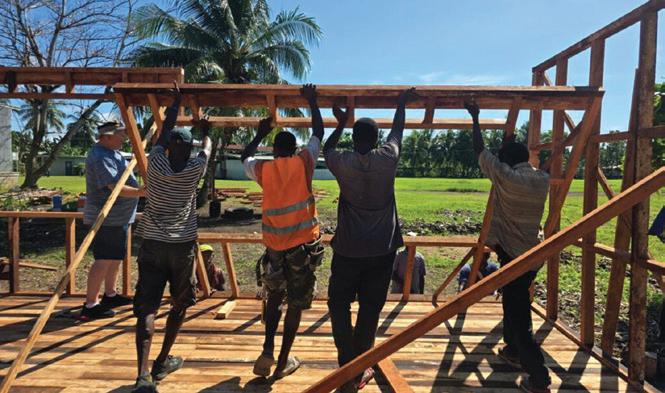
“The
existing school building was eye-opening to behold. It was little more than a shed with a gravel floor, small classrooms with two classes being taught at once, with two teachers in each and blackboards that had been eaten away by white ants. It was easy to see how much this new school building was needed.”
—Sarah Blockley, one of eight volunteers from Tasmania, Australia, and Launceston church member, about the construction and evangelistic program they supported. In June this group travelled to Madang, Papua New Guinea, to help construct new classrooms and support a 10-night evangelistic program, resulting in baptisms and additional decisions for baptism. The volunteers worked alongside locals to haul and stack timber, erect framework, and install roof trusses. On their final Sabbath the team witnessed 44 baptisms at a local beach, followed by a combined worship service attended by an estimated 1,000 people.
The number of young volunteers across Europe that gathered for the tenth anniversary of Invazija Ljubavi (Invasion of Love), a regional outreach organized by the Adventist Development and Relief Agency (ADRA), in Sarajevo, Bosnia and Herzegovina in partnership with the regional youth and children’s departments of the Seventh-day Adventist Church. The initiative unfolded across public parks, retirement homes, stairways, playgrounds, and busy city streets. Cleaning, helping, smiling, listening, painting, and playing were just some of the many activities carried out during the week. Through simple intentional acts of kindness, volunteers brought joy, relief, and connection to hundreds, transforming ordinary spaces into places of hope, compassion, and community. The mayor of the Central District of Sarajevo, Srđan Mandić, personally thanked the team and said, “This kind of work builds bridges. It reminds us that kindness has no borders.”
Do you want to keep up with what is happening in our church? If you want to receive our weekly newsletter that features news, inspirational stories, videos, and more, sign up today.
Adventist church members worldwide were asked if they believe it is necessary to understand people and their needs before preaching the Gospel to them.
“I know that everyone here acknowledges that the inauguration of Ciudad del Cielo is possible only through God’s grace and mercy. . . . The One who gave us gifts now wants us to use them for His glory and honor. May everything that happens here, every activity, be for God’s glory.”
—Abner De los Santos, president of the Inter-American Division, during the inauguration of the Ciudad del Cielo Seventh-day Adventist new church and school building in Santo Domingo, Dominican Republic. Hundreds of Seventh-day Adventist members, leaders, and supporters gathered to celebrate the official inauguration. The project took three years to complete. More than 400 people filled the pews of the new facility.
“There is no doubt that there were many God-inspired moments throughout the week. The impact on the teens is huge, and we believe that many of them will be great leaders in the church’s future. We are really excited to see what God does with the teens who attended. The possibilities are endless.”
—Jeffrey Parker, Australian Union Conference Youth Ministries director, about the CHOSEN teen leadership convention held in Queensland Conference and Camping Centres in Brisbane, Australia. More than 80 teens and their mentors from across the country gathered from July 6 to 11. The event is held every other year since 2008 and invites Adventist teens aged 14 to 16 who have demonstrated leadership ability in their local churches. Each conference also selects two mentors to support the teens throughout the program and continue mentoring them after the event.
The number of tons of food that volunteers from Caleb Mission Project of the Seventh-day Adventist Church and Adventist Development and Relief Agency (ADRA) distributed in food to vulnerable families in the regions of Arequipa and Apurimac, southern Peru. More than 200 young volunteers accepted ADRA Peru’s invitation. Besides distributing food, volunteers also visited families, prayed with them, distributed literature, and supported evangelism in local churches. The Caleb Mission seeks to mobilize young people throughout the continent to live an experience of service, mission, and spiritual transformation.
“Although we faced challenges with an unfamiliar environment and language barriers, the moment patients opened their eyes and smiled brightly after surgery was the true reward of service. Seeing them regain not only their sight but also their hope for life reminded me of my calling as a healthcare professional.”
—Kim EunJin, a nurse who participated in the mission initiative, about a medical mission trip that employees of Sahmyook Medical Center, based in Seoul, South Korea, conducted at Lakeside Adventist Hospital in Kandy, Sri Lanka. The team performed 88 cataract surgeries during the five-day clinic in July. Most of the patients condition made daily life difficult.
Regional church leaders step up to provide shelter and meet necessities.
Edward Rodriguez, Southern Asia-Pacific Division, and Adventist Review
As tensions flared along the Cambodia-Thailand border, the conflict in July displaced tens of thousands of civilians in both countries. In the face of devastation, the Seventh-day Adventist Church has stepped up to offer refuge, compassion, and hope across both territories. “On the fourth day of the cross-border skirmishes, tension had escalated in intensity, with heavier and longer-range weapons deployed by both sides,” regional church leaders reported. “Military operations and territorial gains led to widespread fear and forced evacuations, especially in areas near Preah Vihear Temple and other contested regions.”
On the Thai side, authorities have evacuated more than 140,000 people from Sisaket, Ubon Ratchathani, Surin, and Buriram provinces, where communities near the front lines were most vulnerable. Several Adventist churches in these provinces were forced to close temporarily, regional church leaders reported.
Meanwhile, in Cambodia villagers in Preah Vihear and Oddar Meanchey provinces were also displaced by artillery fire and ground operations. “Several Adventist members from these provinces, particularly from border communities where small house churches and worship groups meet, have fled to safer areas or crossed into Thailand seeking refuge,” church leaders reported.
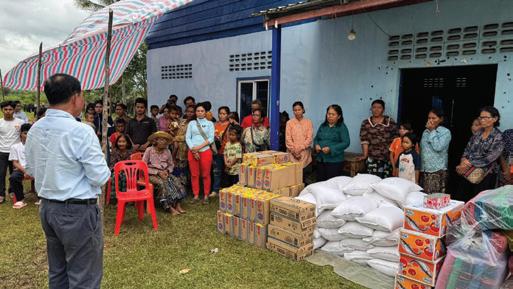
Following the border clash between Cambodia and Thailand on July 24, the Cambodia Mission (CAM) mobilized emergency relief efforts to support church members and families affected by the conflict. On July 27-28 CAM teams traveled to Preah Vihear and Oddar Meanchey to distribute food, water, and essential supplies.
“TOGETHER WE CAN EXTEND THE LOVE AND COMPASSION OF CHRIST TO THOSE WHO ARE SUFFERING.”
because of ongoing fears and uncertainty.”
He continued, “We appeal to your generosity. Please consider supporting these families with your prayers, donations, or resources as they face this time of hardship. Together we can extend the love and compassion of Christ to those who are suffering.”
Leaders also reported that Adventist churches across the Thai border region opened their doors to house displaced families, serving those who arrived from both local and Cambodian border areas. Many more members stayed with friends or relatives, or in government shelters, they shared.
The sudden eruption of tension along the border forced hundreds of families to flee their homes, seeking safety in makeshift shelters, local pagodas, churches, and temporary refugee camps. Among them are hundreds of Seventh-day Adventist church members who have lost access to their homes, livelihoods, and necessities.
“We are witnessing a critical need for food, shelter, and medical care among our brothers and sisters in these provinces,” said Hang Dara, CAM president. “While we thank God that leaders from both countries have met and agreed to a ceasefire, many displaced families remain hesitant to return
A ceasefire agreement eventually was agreed, but tensions remain high as both governments continue to monitor military activities and investigate reported drone sightings. In Thailand the government issued a nationwide ban on drones because of rising security concerns.
Despite these uncertainties, signs of healing eventually emerged. Some refugees on the side of Thailand chose to return home. Adventist leaders have accompanied families during their repatriation, offering spiritual support and helping them resettle.
On Sabbath, August 2, border churches reopened for worship. A wedding was also conducted the following day for two Bible workers whose church lies near the border—a testimony of hope amid hardship.
“Even in the storm,” said a local pastor, “God gives us moments to celebrate love, faith, and community.”

Alberto R. Timm

Some years ago a very kind and sincere woman came to the General Conference headquarters in Silver Spring, Maryland, claiming to be a true prophet. In our dialogue I mentioned that today the word “prophet” carries different meanings but biblically it refers to someone who receives supernatural visions and dreams from God (Num. 12:6). She confirmed that this was her case indeed.
Then I told her that for a true prophet the prophetic message is more important than the phenomenon of being a prophet, but for a false prophet the status of being a prophet is more important than the message itself. She seemed to agree with this distinction as well.
When I asked her what concrete message she had to share, she replied that her message was that the church should remain united. I maintained that this was a message we already know from the teachings of Jesus (John 17:20-23) and Paul (1 Cor. 1:10; Eph. 4:11-14). Realizing that she would not go much further, I told her that one of the issues dividing the church was the matter of women’s ordination. She assured me that she had received a revelation on this matter, but that the Lord would not allow her to share it. “Then in this case,” I replied, “the revelation is no benefit to the church.”
Over the years I have met several other individuals who have tried to convince me of their prophetic gift. But even more common today are preachers who claim that the Lord revealed to them the specific message they should deliver. This phenomenon has led many people to wonder if such claims could be a fulfillment of the promise that in the last days the Lord would pour out His “Spirit on all flesh” (Joel 2:28). So let’s highlight three basic principles that can help us to understand the fulfillment of that important promise.
The first basic principle to keep in mind when dealing with any supernatural revelation is the primacy of the Bible over all charismatic experiences. Regrettably, many Christians today rely on such subjective experiences without testing their legitimacy in the light of Scripture. Some even believe that whoever receives visions, dreams, or any supernatural impression of the mind is in a higher spiritual level than those who do not receive them.
Unquestionably, the Lord can and does reveal Himself in a supernatural way still today, but this should not be regarded as conclusive evidence of true spirituality. In the Bible we have examples of even wicked people who received such revelations without becoming prophets (Gen. 40; 41:1-36; Dan. 2:1-45; 4:127; etc.). Indeed, the highest evidence of a saving faith is to trust God’s Word without any external evidence confirming it (Heb. 11:1). To the doubting Thomas, Jesus stated, “Thomas, because you have seen Me, you have believed. Blessed are those who have not seen and yet have believed” (John 20:29).
In his commentary on Genesis 40:16-19, Martin Luther stated in unambiguous terms, “I have often stated that at the beginning of my cause I always
asked the Lord not to send me dreams, visions, or angels. For many fanatical spirits attacked me, one of whom boasted of dreams, another of visions, and another of revelations with which they were striving to instruct me. But I replied that I was not seeking such revelations and that if any were offered, I would put no trust in them. And I prayed ardently to God that He might give me the sure meaning and understanding of Holy Scripture. For if I have the Word, I know that I am proceeding on the right way and cannot easily be deceived or go wrong.”1
Another basic principle is the crucial task of distinguishing between the reception of supernatural revelations and the call to the prophetic office. Unfortunately, many people believe that as soon as they receive a prophetic dream or other revelation from God, they become prophets. People are even more convinced of a supposed prophetic call if the supernatural revelation unveils hidden issues and/or involves predictions that ultimately are fulfilled. But we should recognize that this is a very complex matter in which people often tend to allow experience to overrule Scripture.
If we study the Bible carefully, we can see that supernatural revelations from God were given not only to true prophets (Num. 12:6) but also to such nonprophets as Mary, the mother of Jesus (Luke 1:26-38), to Gentiles such as the Wise Men from the East (Matt. 2:1-12), to people in a state of apostasy, such as Balaam (Num. 22:7-25, 31-35), and even to animals, such as Balaam’s donkey (Num. 22:21-30). The prophetic dreams of Pharaoh’s chief butler and chief baker (Gen. 40), as well as of Pharaoh himself (Gen. 41:1-36) and Nebuchadnezzar (Dan. 2:1-45; 4:1-27), did not transform them into prophets. This means that prophetic revelations do not necessarily imply a call to the prophetic office.
The prophecy of the end-time outpouring of the Holy Spirit “on all flesh” (Joel 2:28) had a partial fulfillment at the Pentecost (Acts 2:16-21) but will have a much broader fulfillment “before the coming of the great and awesome day of the Lord” (Joel 2:31). In this prophecy, “although God’s covenant with Israel remains the frame of reference, the scope of the prophetic message transcends national and ethnic boundaries to depict a universal Day of the Lord.”2 But this does not mean that everybody will be called to the prophetic office.
While preserving the “diversity of gifts,” in which only “some” are prophets (1 Cor. 12:4-10; Eph. 4:11),

Unquestionably, the Lord can and does reveal Himself still today, but this should not be regarded as conclusive evidence of true spirituality.
the promise of Joel 2:28-32 highlights a global outpouring of the Holy Spirit without any ethnic, gender, or age barrier or discrimination. Then, some “shall dream dreams” and others “shall see visions” (Joel 2:28). But this does not mean that everybody will become a prophet. Indeed, “there are diversities of gifts,” and the Holy Spirit distributes them “to each one individually as He wills” (1 Cor. 12:4, 11). It also does not mean that all human beings will be saved, as some claim today. The text is very clear that only those who call “on the name of the Lord shall be saved” (Joel 2:32; cf. Isa. 56:1-7).
A third basic principle involves the need for the human agent to always hide himself or herself behind the biblical message being presented. Although most of these preachers do not claim to be called to the prophetic ministry or report having visions as true prophets do, they often present such spiritual experience as the primary reason for speaking on a particular topic. No doubt at all that the Lord can and does impress human minds in this way. The problem lies not so much with the phenomenon itself as with the way it is often used to achieve spiritual authority. So if the message came directly from God, then it should be accepted as almost infallible, and the preacher should never be corrected.
Biblical prophets often stated that the Lord revealed Himself to them and even spoke to them in concrete terms, but this was usually to an antagonistic or skeptical audience. Why should nonprophets do the same to receptive audiences? In many cases this kind of personal “testimony” contributes more to the spiritual celebrity of the preacher than to the trustworthiness
of the message. As the sixteenth-century Protestant Reformers, we should ground the authority of our preachers today not in their charismatic experiences but rather “in their faithfulness to the Word of God.”3
Many years ago my brother Edgar (who was a local church elder) was convinced that an angel appeared to him at night, asking him to preach on stewardship in our home church. He made himself available to the church leaders and preached on that topic, but without ever mentioning the angel’s request. That was a valuable lesson for me! He could have impressed his audience with that incident, drawing much attention to himself. Yet he decided to allow the message to speak for itself without giving the impression that he was on a higher spiritual level.
Unfortunately, spiritual arrogance limits God’s revelation to us. If the Lord gave us prophetic dreams or visions, or sent us angels in visible form, such experiences could easily nourish our spiritual pride. We could be easily tempted to consider ourselves better Christians, sharing “testimonies” that exalt ourselves more than God and His Word. As a result, many people would be more attracted to us than to the Lord.
In a world full of spiritual “celebrities,”4 why not humble ourselves and allow the Spirit to use us powerfully in His cause, without boasting about our own spiritual experiences and accomplishments? We can be on much safer ground by recognizing the primacy of the Bible over all charismatic experiences, distinguishing between the reception of supernatural revelations and the call to the prophetic office, and hiding ourselves behind the biblical message. Then the Holy Spirit can work more effectively through us!
1 Martin Luther, in Luther’s Works, ed. Jaroslav Pelikan, American Edition (St. Louis: Concordia Publishing House, 1955-1976), vol. 7, pp. 119, 120 (WA 44:387).
2 Elias Brasil de Souza, “Joel,” in Andrews Bible Commentary: Old Testament, ed. Ángel Manuel Rodríguez (Berrien Springs, Mich.: Andrews University Press, 2020), p. 1083.
3 Alister E. McGrath, Reformation Thought: An Introduction, 4th ed. (Chichester, UK: Wiley-Blackwell, 2012), p. 99.
4 See Katelyn Beaty, Celebrities for Jesus: How Persons, Platforms, and Profits Are Hurting the Church (Grand Rapids, Mich.: Brazos Press, 2022).
Alberto R. Timm is recently retired after 43 years of ministry as a pastor, Ellen G. White Estate associate director, and BRI associate director.
Can Christians committed to sola scriptura believe in a modern-day prophet?

Heinz Schaidinger

on the Adventist.org website, the 28 fundamental beliefs are introduced as follows: “Upholding the Protestant conviction of Sola Scriptura (“Bible only”), these 28 Fundamental Beliefs describe how Seventh-day Adventists interpret Scripture for daily application.”1
Adventist theologians emphasize sola scriptura (the Scriptures alone). Yet Christians from other denominations—and admittedly some within our own—express a certain uneasiness regarding our acceptance of the presence and authority of an extra-biblical prophet, as well as her messages to humanity and to the Adventist Church in particular. How can we profess to be obliged to the Protestant Reformers’ sola scriptura and yet at the same time accept still another source of divine messages that is—technically speaking—extra-biblical? By this, of course, we refer to Ellen G. White and her writings.2
For 70 years Ellen G. White played a significant role within the Adventist Church, of which she was a founding member. By fellow Adventists she was accepted as a prophet. Much of what she wrote resulted from visions, audible messages, and dreams. Her role as a special messenger of the Lord was a stumbling block for many Protestant fundamentalists, who otherwise would have agreed with many Adventist principles and convictions.3
But is it truly justified to view her ministry as a hindrance for Protestant fundamentalists, or are we confronted with a simple misunderstanding? Have Seventh-day Adventists left the sola scriptura principle of the Reformation and replaced it with an end-time prophet?4 If Ellen White is really a messenger chosen by the Lord, did God break the sola scriptura principle Himself?
A contradiction between the existence and message of writings inspired by the Spirit of Prophecy and the Bible, which was inspired by
the same Spirit, cannot logically be established. Neither in theological theory nor in exegetical practice. The testimony of Jesus cannot be placed above, beside, or below Scripture, but it is beyond any doubt rooted in Scripture itself.5 Those who truly want to take a stand in favor of sola scriptura have therefore no choice: they must accept the testimony of Jesus. It is because of our earnest belief in the Bible that we accept the Spirit of Prophecy wherever and whenever we meet it, even at the time of the end. Those who want to separate the testimony of Jesus from Scripture violate the very principle they profess to defend. If “Scripture alone” is a valid claim, then all the biblical teachings are valid, including the teaching concerning the Spirit of Prophecy. Creating an artificial contradiction between the two leads to a paradox. This is the unanimous testimony of our pioneers:
“I recommend to you, dear reader, the Word of God as the rule of your faith and practice. By that Word we are to be judged. God has, in that Word, promised to give visions in the ‘last days’; not for a new rule of faith, but for the comfort of His people, and to correct those who err from Bible truth.”6
“The position that the Bible, and the Bible alone, is the rule of faith and duty does not shut out the gifts which God set in the church. To reject them is shutting out that part of the Bible which presents them. We say, Let us have a whole Bible, and let that, and that alone, be our rule of faith and duty. Place the gifts where they belong, and all is harmony.”7
“The Protestant principle, of ‘The Bible and the Bible alone,’ is of itself good and true; and we stand upon it as firmly as one can; but when reiterated in connection with outspoken denunciation of the visions, it has a specious appearance for evil. So used it contains a covert insinuation, most effectually calculated to warp the judgment of the unguarded, that to believe the visions is to leave the Bible, and to cling to the Bible is to discard the visions.”8
It is because of our earnest belief in the Bible, that we accept the Spirit of Prophecy wherever and whenever we meet it, even at the time of the end.
THE SAME SOURCE
The phrase “the Bible, and the Bible alone” was never used among Adventists to create a contradiction between the Holy Scriptures and the testimony of Jesus. Both testify to one another, both lead to one another, both have the same Source, which is the Spirit of God. Correctly used, this battle cry of the Reformation has the power to discern teachings that are not in harmony with the biblical testimony. Teachings that are rooted in human tradition, and teachings held by so-called spiritually led fanatics who believe that they don’t need Scripture anymore because of having received the Spirit. The Reformers used sola scriptura to wage a war against both fronts: Roman Catholic tradition, and Scripture-less spiritualism. Today sola scriptura continues to be the believer’s weapon against both ideological pitfalls.
“The Roman Church has not relinquished her claim to supremacy; and when the world and the Protestant churches accept a sabbath of her creation, while they reject the Bible Sabbath, they virtually admit his assumption. They may claim the authority of tradition and of the Fathers for the change; but on so doing they ignore the very principle which separates them from Rome—that ‘the Bible, and the Bible only, is the religion of Protestants.’ ”9
“The Spirit was not given—nor can it ever be bestowed—to supersede the Bible; for the Scriptures explicitly state that the Word of God is the standard by which all teaching and experience must be tested. . . .
“Great reproach has been cast upon the work of the Holy Spirit by the errors of a class that, claiming its enlightenment, profess to have no further need of guidance from the Word of God. They are governed by impressions which they regard as the voice of God in the soul. But the spirit that controls them is not the Spirit of God.”10
ELLEN G. WHITE: A PARADOX?
In the writings of Ellen G. White you can find numerous more examples.11 She uses sola scriptura in the same way as the Reformers12: against purely human ideas, apostasy, the human religion of words,
formalism, tradition and “creeds” of human beings, traditions of the Roman Catholic Church, traditions of Protestantism, a theology disobedient to God’s law, the sayings and doings of humanity, human wisdom (which leads to the road of perdition), even against the false visions of Anna Phillips. Ellen White explains that the Bible alone allows us to understand end-time events in history and politics today,13 and that the Bible only gives us a correct understanding of eschatology.14 She is saying this in harmony with the obvious and well-known fact that she herself wrote extensively on eschatological subjects, explaining last-day events.
“The Bible contains all that is needful for the saving of the soul.”15 And yet she expresses herself also in the following way: “Study it [the Bible] and the testimonies God has given; for they never contradict His Word.”16 Would this be a contradiction, a paradox? By no means! Not when both the Bible and the extra-biblical prophecy come from the same Source: the Spirit of God! Sola scriptura is the principle and alarm cry against those who want to supersede and replace the Bible to make it powerless; be it through human tradition that contradicts the Bible, or through delusions of the “Spirit” where the Bible would no longer be needed These are the enemies toward which the battle cry of sola scriptura is directed, to defend and vindicate the Bible and its authority against those who try to belittle and overcome it!
“One of Satan’s most effective techniques has been to discredit one truth by pretending to exalt another. Here is a classic example. Ellen White is attacked by people who claim to want to hear only the Bible, but who reject that portion of the Scriptures that foretells the gift of prophecy in the last days. . . .
“Remember, too, that the Son of God was crucified at the insistence of theologians who rejected His message with the concept of sola scriptura. They had Moses; they had no intention of listening to a Galilean carpenter. And thereby they rejected the Creator Himself.
“The expression sola scriptura arose out of the Protestant Reformation. The question then was, What is the source of prime authority in matters of faith and
practice? For Rome, it was the church. For Protestants, it was the Bible and the Bible alone—not the Bible and tradition. Recognizing that conflict as the origin of the expression sola scriptura, we cannot allow it to split the Bible away from its own doctrine of spiritual gifts. ‘The Bible and the Bible alone’ was never meant to pit Scripture against the gift of prophecy, for both arise from the same Holy Spirit.”17
Ellen White herself argued vigorously and with fervor against the enemies of sola scriptura With the Bible raised up in her hand, she virtually judges both human tradition and “spiritual enlightenment.” There cannot be the genuine Spirit of God, through any argumentation whatsoever, where the Bible is neglected or even bypassed and contradicted. Sola scriptura maintains the Bible against all those who don’t want to follow the Bible fully.
Why, then, would sola scriptura be used against those who fight to uplift and defend the Bible? How, then, could the sola scriptura principle be used against a genuine prophet who, beyond any doubt, fights herself as a friend and follower of sola scriptura against its foes and oppressors? This is a paradox and devoid of any logic.
Do we really want to cry “the Bible and the Bible alone” against the modern prophet and thus silence God Himself, who wants to reach us in the last days through an instrument of His choice, whose message is in complete harmony with the Bible?18
1 https://adventist.org/beliefs
2 See fundamental belief 18, The Gift of Prophecy, at https://adventist.org/beliefs#belief-18.
3 U.S. Catholic, September 1965, pp. 27ff.
4 As it is the case with Joseph Smith of the Latter-day Saints, or with Sun Myung Moon of the Unification Church.
5 Rev. 12:17; 19:10; 22:8, 9; Eph. 4:4-16; 2:20. The Bible itself is nothing else than the “testimony of Jesus,” testified to by God-fearing people through the Spirit of Prophecy (1 Peter 1:10, 11).
6 Ellen G. White, Early Writings (Washington, D.C.: Review and Herald Pub. Assn., 1882, 1945), p. 78. The binding authority of the Spirit of Prophecy, therefore, tends to increase the more we err from Bible truth.
7 James White, in Review and Herald, Oct. 3, 1854.
8 Uriah Smith, in Review and Herald, Jan. 13, 1863.
9 Ellen G. White, The Great Controversy (Mountain View, Calif.: Pacific Press Pub. Assn., 1911), p. 448.
10 Ibid., p. vii. (Emphasis added.)
11 Compare, for example, ibid., pp. 145-170, 335-342, 395-399.
12 The Reformers of the sixteenth century did not invent the sola scriptura principle. It is enrooted in the Bible itself (e.g., Isa. 8:19, 20; Matt. 15:7ff.), but the Bible never applies it against true prophecy—be it biblical or extra-biblical (compare Jer. 26:16-19).
13 Ellen G. White, Prophets and Kings (Mountain View, Calif.: Pacific Press Pub. Assn., 1917), p. 537.
14 Ellen G. White, Education (Mountain View, Calif.: Pacific Press Pub. Assn., 1903), pp. 179ff.
15 Ellen G. White, Counsels to Parents, Teachers, and Students (Mountain View, Calif.: Pacific Press Pub. Assn., 1913), p. 448; in Review and Herald, Dec. 15, 1896.
16 Ellen G. White, Selected Messages (Washington, D.C.: Review and Herald Pub. Assn., 1980), book 3, p. 32. Emphasis added.
17 Lewis R. Walton, Decision at the Jordan (Washington, D.C.: Review and Herald Pub. Assn., 1982), pp. 39, 40.
18 That’s what the people of Israel did in their days, thus rejecting God’s grace! “Then I raised up some of your sons to be prophets, and some of your young men to be Nazirites. Is this not so, you sons of Israel? declares the Lord. But you made the Nazirites drink wine, and you commanded the prophets, saying, ‘You shall not prophesy!’ ” (Amos 2:11, NASB). Thus the Israelites silenced God Himself. Yet “certainly the Lord God does nothing unless He reveals His secret plan to His servants the prophets. . . . The Lord God has spoken! Who can do anything but prophesy?” (Amos 3:7, 8, NASB).
Heinz Schaidinger is a professor of Old Testament and practical theology at Bogenhofen Seminary, Austria
“ Who WAS eLL en g . White?”
is Ellen G. White, the visionary cofounder of Seventh-day Adventism, relevant beyond her own denomination? Smithsonian Magazine thought so, and included her alongside George Washington, Abraham Lincoln, and Helen Keller in a listing of the “100 Most Significant Americans of All Time.”1
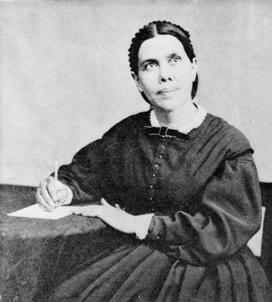
Born in 1827, White suffered a near-fatal injury at age 9, was baptized into the Methodist Church at 12, and faced the “Great Disappointment” at 16. Beginning in 1844, she received many hundreds of visions and prophetic dreams over a 70-year ministry. She wrote some 100,000 pages on a wide range of topics (including education, theodicy, health, psychology, church-state relations, Christology, church governance, history, ethics, prophecy, and homiletics) and traveled across North America, Europe, and Oceania, founding schools, churches, medical institutions, and publishing houses.2 Her perseverance was reflected in her last words: “I know in whom I have believed.”3
The unity of sola scriptura and the gift of prophecy is key to understanding the reason for Ellen White’s writings. Since the Bible is the “uniquely normative” standard, any prophetic claims must first be tested by the canon, and second accede all claims of authority to the Bible.4 As such, Seventh-day Adventists see Ellen G. White’s writings as a fulfillment of Scripture, subject to the authority of Scripture, and pointing back to Scripture.
One hundred ten years after her death, Seventh-day Adventists continue to uphold the relevance and tremendous blessing of her prophetic gift.
While Smithsonian used big data to rank Ellen White’s global impact, she anchored her legacy in a Christ-centered, theologically grounded prophetic mission. As she put it: “Whether or not my life is spared, my writings will constantly speak, and their work will go forward as long as time shall last.”5
1 https://www.smithsonianmag.com/smithsonianmag/meet-100-most-significant-americans-all-time-180953341/
2 Denis Fortin and Jerry Moon, The Ellen G. White Encyclopedia (Hagerstown, Md.: Review and Herald Pub. Assn., 2013), pp. 18, 82.
3 Ellen G. White, Life Sketches of Ellen G. White (Mountain View, Calif.: Pacific Press Pub. Assn., 1915), p. 449. See also Ellen G. White manuscript 78, 1910; manuscript 19, 1892.
4 John C. Peckham, “The Prophetic Gift and Sola Scriptura,” Faculty Publications, Feb. 7, 2021, pp. 400-404.
5 Ellen G. White to F. M. Wilcox, letter 371, 1907.
Jonathan Gomide is a research and digitization assistant at the Ellen G. White Estate.
This section features original art created by Seventh-day Adventist artists from around the world. Featured art is curated by Jonathan
editor of the Adventist Review. Visit adventistreview.org/art for more original Adventist art.

By Lin Pacific
Christ, in black and white to indicate the tough battle, endures pain yet keeps His eyes on the Father, resolute to follow the golden path for humanity’s salvation. From the cross, the path becomes a golden river of blessing flowing toward humanity.
Lin Pacific is a South African artist, poet, and author of children’s books, and is currently a Signature member on the Board of the Nevada Watercolor Society in Las Vegas, Nevada. Visit linktr.ee/LinPacific for more.
To submit any type of original Adventist art (poetry, music, painting, drawing, film, photography, sculpture, etc.), please contact art@adventistreview.org. Submission does not guarantee publication. Creative works showcased do not imply an automatic endorsement of all works by featured artists.
POETRY
(Based on Luke 8:43-48)
By Roy E. Gane
Lonely and weak, Lost in the crowd. People pushing, Aggressive and loud.
If I could reach Him, My trouble would end. If I could touch Him, I would be cleansed.
But my touch would defile His divine purity. What would He say? How annoyed would He be?
Perhaps if I touch His coat on the border, I can be healed Without causing disorder.
I’ll sneak up behind Him As close as I dare, And reach out a hand, I’m almost there.
Struggling and jostling With all my strength, Stretching my arm Its total length.
I touched it! I touched it! And what is that feeling? The power flows through me With God-given healing!
Hallelujah, Adonay! I want to shout, But what is He doing? He’s turning about.
He’s asking who touched Him In all of this horde. He felt power go forth In the name of the Lord.
He’s looking at me And the secret I’m holding. I must confess all And submit to His scolding.
I come trembling toward Him And there I fall.
“I did touch You, Jesus, But You made me well!”
The crowd parts and listens To hear His reply. I’m so embarrassed, I think I will die.
But smiling, He says With a voice like a bell, “Go in peace, daughter; Your faith made you well!”
He made me clean, But my touch, of course, Could never pollute Him, The purity Source.
So smiling, He said With a voice like a bell, “Go in peace, daughter; Your faith made you well!”
Roy E. Gane is professor of Hebrew Bible and ancient Near Eastern languages at the Seventh-day Adventist Theological Seminary, Andrews University, Berrien Springs, Michigan.
the leaders in God’s cause, as wise generals, are to lay plans for advance moves all along the line. In their planning they are to give special study to the work that can be done by the laity for their friends and neighbors. The work of God in this earth can never be finished until the men and women comprising our church membership rally to the work and unite their efforts with those of ministers and church officers.
The salvation of sinners requires earnest, personal labor. We are to bear to them the word of life, not to wait for them to come to us. Oh, that I could speak words to men and women that would arouse them to diligent action! The moments now granted to us are few. We are standing upon the very borders of the eternal world. We have no time to lose. Every moment is golden and altogether too precious to be devoted merely to self-serving. Who will seek God earnestly and from Him draw strength and grace to be His faithful workers in the missionary field? . . . There should be a well-organized plan for the employment of workers to go into all our churches, large and small, to instruct the members how to labor for the upbuilding of the church and also for unbelievers. It is training, education, that is needed. Those who labor in visiting the churches should give the brethren and sisters instruction in practical methods of doing missionary work. . . .
God calls for greater piety, for holiness of life and purity of conduct.
Ellen G. White
Nothing will so arouse in men and women a self-sacrificing zeal as to send them forth into new fields to work for those in darkness. . . . It is the positive duty of God’s people to go into the regions beyond. Let forces be set at work to clear new ground, to establish new centers of influence wherever an opening can be found. Rally workers who possess true missionary zeal, and let them go forth to diffuse light and knowledge far and near. Let them take the living principles of health reform into the communities that to a large degree are ignorant of these principles. . . .
Young men and women should be educated to become workers in their own neighborhoods and in other places. Let all set their hearts and minds to become intelligent in regard to the work for this time, qualifying themselves to do that for which they are best adapted.
Many young men who have had the right kind of education at home are to
be trained for service and encouraged to lift the standard of truth in new places by well-planned and faithful work. By associating with our ministers and experienced workers in city work, they will gain the best kind of training. Acting under divine guidance and sustained by the prayers of their more experienced fellow workers, they may do a good and blessed work. As they unite their labors with those of the older workers, using their youthful energies to the very best account, they will have the companionship of heavenly angels. . . .
All this work of training should be accompanied with earnest seeking of the Lord for His Holy Spirit. Let this be urged home upon those who are willing to give themselves to the Master’s service. Our conduct is watched by the world. Every act is scrutinized and commented upon. . . . God calls for greater piety, for holiness of life and purity of conduct, in accordance with the elevating, sanctifying principles that we profess. The lives of the workers for Christ should be such that unbelievers, seeing their godly walk and circumspect conversation, may be charmed by the faith that produces such results.
This excerpt was taken from Testimonies for the Church, vol. 9, pp. 116-120. Seventh-day Adventists believe that Ellen G. White (18271915) exercised the biblical gift of prophecy during more than 70 years of public ministry.
have you ever wished life came with a remote control?1 One that you could hit the rewind and replay buttons to undo that mistake, make a different choice, stop the trauma before it happened, or prevent that painful experience altogether. Of course, there is no such physical remote. And yet we often live as if there is—replaying things over and over in our minds, as if sheer thought could rewrite history. And the more we fixate on what went wrong, the more stuck we become. This is Satan’s trap of rumination (Prov. 14:12)—reliving what we can’t revise, and being anchored to moments we were never meant to live in forever.

K’dee Crews
This is where the story of the Israelites comes in. They knew something about being stuck—stuck in slavery and stuck in the wilderness, circling the same terrain for years. Their journey from Egypt to the Promised Land offers us more than a historical insight; it provides us with a mental health road map for healing. So let us put on our virtual reality glasses and step into their journey as if it were our own, because in many ways it is. As we walk through their story, we’ll learn how to move past pain and pursue a promised future of healing, hope, and wholeness. Instead of “rewind” and “replay,” we will discover how to “restart.”

When we read about Israel’s life of slavery in Egypt, we often focus on the miracles of deliverance and skip over the deep trauma they endured.
The book of Exodus reveals a dark reality: a people who lived under slavery and suffered generational trauma for more than 400 years (Ex. 12:40). This wasn’t just physical oppression; it was psychological, emotional, and spiritual bondage passed down like a family heirloom.
Exodus 1 details the brutal existence of the Israelites in Egypt: forced labor, chronic oppression, and systemic injustice at the hands of racist taskmasters. They were seen, not as people, but as property. Egypt did not just enslave their bodies—it enslaved their minds.
The deeper trauma came from the stripping away of their faith and culture. Ultimately this robbed them of dignity and erased their identity.
Once honored through Joseph (Gen. 41), they were now forced to suppress their customs and faith and adopt Egyptian worship and norms.
When God, the Creator, later said, “Remember the Sabbath” (Ex. 20:8; see also Deut. 5:15), it was not just about rest—it was a call to reclaim their freedom, faith, and identity.
So what about you? What is your Egypt—the traumas, challenges, or adversities that have marked your journey? Abuse, abandonment, anxiety, addictions, resentments, failure, false identity, depression, and disappointment. Whether your wounds are physical, emotional, relational, spiritual, or all the above, life has a way of enrolling each of us in the University of Adversity. The more pressing question is not whether we’ve been accepted into its halls, but rather: Will we graduate? Will we receive the therapy and healing that God offers us?
If the Israelites lived today, they would likely be diagnosed with Post-traumatic stress disorder (PTSD), anxiety, depression, complicated grief, and a long list of other mental health issues. They would need therapy, which is precisely what they received. Guided by the Wonderful Counselor (see Isa. 9:6), they embarked on a divine journey of healing. Their story provides us with a four-step framework for healing.
Cross: Leave your past behind (Joshua 1:1-5:12).
Conquer: Fight the battles and claim a new life (Joshua 1:10, 11; 5:13-12:24).
Divide: Settle into your new life (Joshua 1:12-15; 12:1-21:45).
Devote: Stay connected to Life and share life with others (Joshua 1:16-18; 22:1-24:33).
Why didn’t God lead them straight from Egypt into the Promised Land? Because while they were out of Egypt, Egypt was still in them. God knew that the Israelites were addicted not just to food and, compared to the desert, comfort, but to the past. Repeatedly they cried, “If only we were back in Egypt!” (see Num. 14:2-4). Sound familiar? Many of us find ourselves stuck re-reading the first chapter of our lives when God is trying to write a new one. As trauma specialist Peter Levine wisely noted, “Trauma is a fact of life. It does not, however, have to be a life sentence.” Although trauma can make us crave the familiarity of bondage over the uncertainty of freedom, God is calling us to cross over from Egypt, through the wilderness, to the Promised Land. “Forget the former things; do not dwell on the past” (Isa. 43:18, NIV).
God did not abandon His people in the wilderness. Instead the wilderness served as God’s treatment center—a sacred space for detox and deliverance. He aimed not only to bring them to a new place; He was trying to get them to become a new people with a new mindset (Rom. 12:2). He sought to detox them from Egypt’s lies and false gods while teaching them to see Him, trust Him, and follow Him—all lessons essential to live in the Promised Land. Through the law (especially the Sabbath; Ex. 20; Deut. 5), His sanctuary (Ex. 25:8), and many miracles, the Israelites learned the truth of God’s character and their identity in Him. Sadly, for most of the Israelites, their addictions, particularly to the past, ran so deep that a 40-year detox was not sufficient, requiring a full generational reset. Only two individuals, Joshua and Caleb, had the renewed mindset necessary to move forward into the Promised Land.
God did not abandon His people in the wilderness. Instead, the wilderness served as God’s treatment center—a sacred space for detox and deliverance.
Like many of us today, Israel desired instant healing. They wanted the Promised Land without the wilderness. They groaned and complained. But it’s not just about the destination; it’s about the journey we take to get there. Healing, like sanctification, is a journey that is often uncomfortable, slow, messy, and lengthy. “Sanctification is not the work of a moment, an hour, a day, but of a lifetime. It . . . is the result of constantly dying to sin, and constantly living for Christ.”2 The wilderness journey is where God detoxifies us from Egypt and transforms us from slaves into sons—not despite the struggle, but through it.
As you reflect on your life, what is your wilderness—the space where God is trying to reshape, retrain, and heal your heart and mind? Whatever it is, don’t despise the process or run away from it. The wilderness may feel barren, but it’s where God does His most transformative work. Will you let Him lead you through it so you can make your way to the Promised Land He has prepared for you?
After 40 years of wandering in the wilderness, the Israelites entered the Promised Land. Hallelujah! The journey was over! Not quite. It had only just begun. Yes, God had promised them the land, and it was already theirs by divine decree. But they still had to fight for it. The Promised Land was a gift, but it wasn’t handed to them without effort. They had to partner with God to possess what He had already promised. As Ellen White so powerfully said: “Divine power combined with human effort will give to all perfect and entire victory.”3
The first major battle and example of this collaboration was the fortified city of Jericho. The Israelites simply marched, worshipped, and trusted Yahweh as God Himself brought the walls tumbling down. This miracle demonstrated to the Israelites (and
neighboring nations) that they conquered through obedience and partnership with the Divine, not through human military strength.
The same is true for us. Stepping into healing, freedom, or purpose doesn’t mean the battles will suddenly disappear. There will still be giants in the land—obstacles, strongholds, and struggles. Don’t retreat in fear to the wilderness; instead, charge ahead as a conqueror! Remember, the God who called you out of Egypt will equip you to conquer every battle ahead. The same God who parted the Jordan will also bring down your Jericho walls. He doesn’t just promise victory—He invites you to walk in it, step by step, hand in His hand, all the way to the Promised Land.
Isaiah 43:18, 19 notes not only the call to cross over but also the call to conquer: “Forget the former things; do not dwell on the past. See, I am doing a new thing! Now it springs up; do you not perceive it? I am making a way in the wilderness and streams in the wasteland” (NIV). Stop replaying the trauma (or even romanticizing the “good old days”). Stop living in yesterday’s miseries (or miracles). And stop dwelling on the past by focusing on the present, the new thing God is doing. Rather than dwelling on Egypt, look forward and see that He is making a way through the very wilderness and the wasteland of our lives.
What exactly was the Promised Land? Yes, it was a geographical place, but it signified so much more. The Promised Land represented:
• A land of rest after generations of striving.
• A land of abundance (milk and honey) after scarcity.
• A land of belonging, identity, and legacy.
• A land of wholeness and healing after brokenness and trauma.
• A land of divine fulfillment—the promise finally realized.
Even more remarkable is how God speaks about this land. In Joshua 1:2, 3 He tells Joshua to take the land He is giving them (conquer it!) and then speaks of it as though it’s already theirs. Scholars call this the “prophetic perfect”—when God speaks of future promises as though they are already fulfilled.
What battles do you need to fight and conquer as you enter your Promised Land? What promises can you claim as you leave your past and enter your future life? One of many promises you can claim is found in 2 Corinthians 5:17: “Therefore, if anyone is in Christ, the new creation has come: The old has gone, the new is here [now]!” (NIV). Claim God’s newly created life for you—it is a prophetic perfect! It is both a promise and an inheritance.
Once the Israelites crossed into the Promised Land and conquered their enemies, they had to divide the land. This was not merely about drawing boundaries on a map; it was about settling into a new land and life. Sounds easy, right? Imagine the life of the Israelites. When all you have known is life as an immigrant and nomad, how easy is it to embrace and live a life of stability and serenity? This was foreign and strange to the Israelites. I often see this with my clients who heal from mental illness. As they experience the freedom and joy of wholeness, they often feel paralyzed by how to live in this newness of life. If depression, anxiety, resentment, and hopelessness are all you’ve known, it’s not always easy at first to live a new life of joy, hope, forgiveness, and freedom. Although bondage and brokenness feel comfortable, we must break free from the familiar and step into the unknown. Satan will tempt us to return to Egypt, just as he did with the Israelites: “We should choose a leader and go back to Egypt” (Num. 14:4, NIV; cf. Ex. 16:3; Num. 11:4-6). But we must cross over, conquer, and divide! Pray. Dream. Set goals. And do all of this with intentionality and faith! Too often we emerge from painful seasons feeling cautious, hesitant, and small in our thinking. But remember—you are praying to the same God who split the Red Sea, rained down manna, and brought water from rocks. The God of old is the same God who now invites you to pray and dream boldly, to set goals that reflect not your capabilities but His. Charles Spurgeon wrote, “You do not honor God by asking for small things. He is a great King and likes to be honored with great requests.” We come boldly to his throne knowing that He can “do exceedingly abundantly above all that we ask or think” (Eph. 3:20). God didn’t bring the Israelites out of Egypt and through the wilderness to live small—He brought them to the Promised Land to live free and abundantly What does dividing the land look like in your life? What plans and priorities do you

God didn’t bring the Israelites out of Egypt and through the wilderness to live small—He brought them to the Promised Land to live free and abundantly.
need to establish to fully live in this newfound freedom and life God has given you? Make space for healing to take root. Make room for joy. Don’t just visit the Promised Land of freedom and wholeness—inhabit it. And because you can’t do it alone—pray, pray, pray. You may have heard it said before that the size of our prayers (dreams and plans) reflects the size of our God. How big is your God? And how different would your future look if you prayed to and believed in the same God of the Israelites?
After the land was divided and the Israelites began to settle, Joshua gathered the people and reminded them to “choose . . . this day whom you will serve” (Joshua 24:15). The Promised Land, you see, wasn’t just a gift— it was a call to devotion. We sometimes read God’s call for devotion and obedience as an egocentric request, but when we are devoted to the Lifegiver Himself, we receive the blessing of life. This devotion wasn’t legalism; it was their maintenance plan for joy and freedom. Devotion is about staying close to the God who brought you this far, remembering His goodness, and walking in daily communion with Him.
The healing journey doesn’t stop there. With healing comes a devotion to mission. Freedom and life aren’t just for us; they are meant to overflow into the lives of others. The Promised Land isn’t a private reward; it’s a platform. The Israelites

were to be a light on a hill (Matt. 5:14-16) to illuminate the dark lives of surrounding nations.
Now that you’ve witnessed God’s power and experienced His redemption, you are called to bear witness. You are called to be living proof that freedom is possible. Your scars become testimonies. One of my favorite passages to share in therapy is 2 Corinthians 1:3, 4: “Praise be to the God and Father of our Lord Jesus Christ, the Father of compassion and the God of all comfort, who comforts us in all our troubles, so that we can comfort those in any trouble with the comfort we ourselves receive from God” (NIV). Your comfort becomes their comfort. Your healing becomes hope for someone else, showing them that they, too, can reach the Promised Land. So get settled in—but don’t get silent. Share, serve, and stay connected to the Source, allowing your life to speak to those who are still stuck in Egypt, still wandering in the wilderness. The same God who brought you through is still in the business of deliverance, and now He wants to use you to help others cross over.
We all go through Egypt, and we all wander through wilderness seasons. But God never intended for us to stay stuck in Egypt or wander in the wilderness forever. He is calling us to cross over—from trauma to transformation, from bondage to blessing, from captives to conquerors. It won’t be easy, but the land is already yours. Your future is already promised. The only question is: Are you ready to leave the past behind? Let us be like Paul, who said, “One thing I do: Forgetting what is behind and straining toward what is ahead” (Phil. 3:13, NIV).
The Promised Land is waiting. Let’s cross over.
1
2
3
K’dee Crews, Ph.D., is a licensed clinical psychologist and clinical director at Beautiful Minds Medical in Auburn, California, United States
The doctrine that led me to the Truth
It hit me that truth, as in the Truth, had to be out there somewhere.
Since 1979 I have been giving my testimony. The narrative itself has not budged, but, as I have over and over recounted it, insights—sometimes amazing, and never thought about before—come to mind. (And sometimes blowing my mind, too.)
Recently, after almost 50 years, something hit me that, though crucial to my new birth, occurred a few years before it. I grew up a secular Jew in a secular Jewish culture, Miami Beach, Florida. (I don’t remember anyone keeping Sabbath, ever.) Intellectually pickled in this brine, I was raised and educated on an über postmodern worldview. Truth was subjective, cultural, personal, contingent. You have your truth, I have mine, that kind of stuff. I was a fundamentalist relativist, no matter how self-refuting that position is (think about it).
My dogmatic worldview, however, shattered in 1976 (I was 21 years old), when it hit me that truth, as in the Truth, had to be out there somewhere. I mean, the universe, all creation, it is real, it is here, and we are part of it, too. The 93-billion-lightyear-wide cosmos (at least what we can observe, so far) and all that’s in it exists, and so someone (something) had to have created it, and whoever (whatever) created it was the foundation and source of all reality—that is, it was the Truth. I had no idea what it (the Truth) was, nor any reason to believe that I ever could know it; for me, the life-changing revelation was that it (the Truth) not only “was” but had to be.
Then, a few months ago, I suddenly realized that what caused this life-changing revelation for me was the doctrine of—creation. Creation! Again, the universe, the created cosmos, it’s here, and to know the source of, the cause of, and the reason it’s here is to know what had to exist: the Truth. How fascinating, then, that in my quest for the Truth (for as soon as I knew it had to exist, I wanted to know it) I was led (about three years later) right to the Seventh-day Adventist Church, whose name itself witnesses to how foundational the doctrine of creation is. And not only creation

but also the six days of creation, with God resting on the seventh. “And on the seventh day God ended His work which He had done, and He rested on the seventh day from all His work which He had done. Then God blessed the seventh day and sanctified it, because in it He rested from all His work which God had created and made” (Gen. 2:2, 3).
And this, the seven-day creation account, as depicted in Genesis, is just as important as the creation itself, because theistic evolution, any model, requires billions of years of violence, suffering, and death in order to create humanity, which would make Christ’s sacrifice on the cross, which promises to end suffering, violence, and death—meaningless. Unless, of course, Christ died to save humanity from the very process (violence, suffering, and death) that Christ (John 1:3) used to create humanity to begin with. If that sounds ludicrous, it is because it is.
Though it took almost 50 years to hit me, when it did I was amazed at the realization that, of all things, it was the doctrine of creation that had led me to believe that truth, as in the Truth, had to exist; and, then, in my search for the Truth, I was led right to Seventh-day Adventists. And yet, if you think about it, what other doctrine would have done that, and also (if you think about it more), where else should it have led me?
Clifford Goldstein is the editor of the Adult Bible Study Guide. His latest book is An Adventist Journey, published by the Inter-American Division Publishing Association (IADPA).
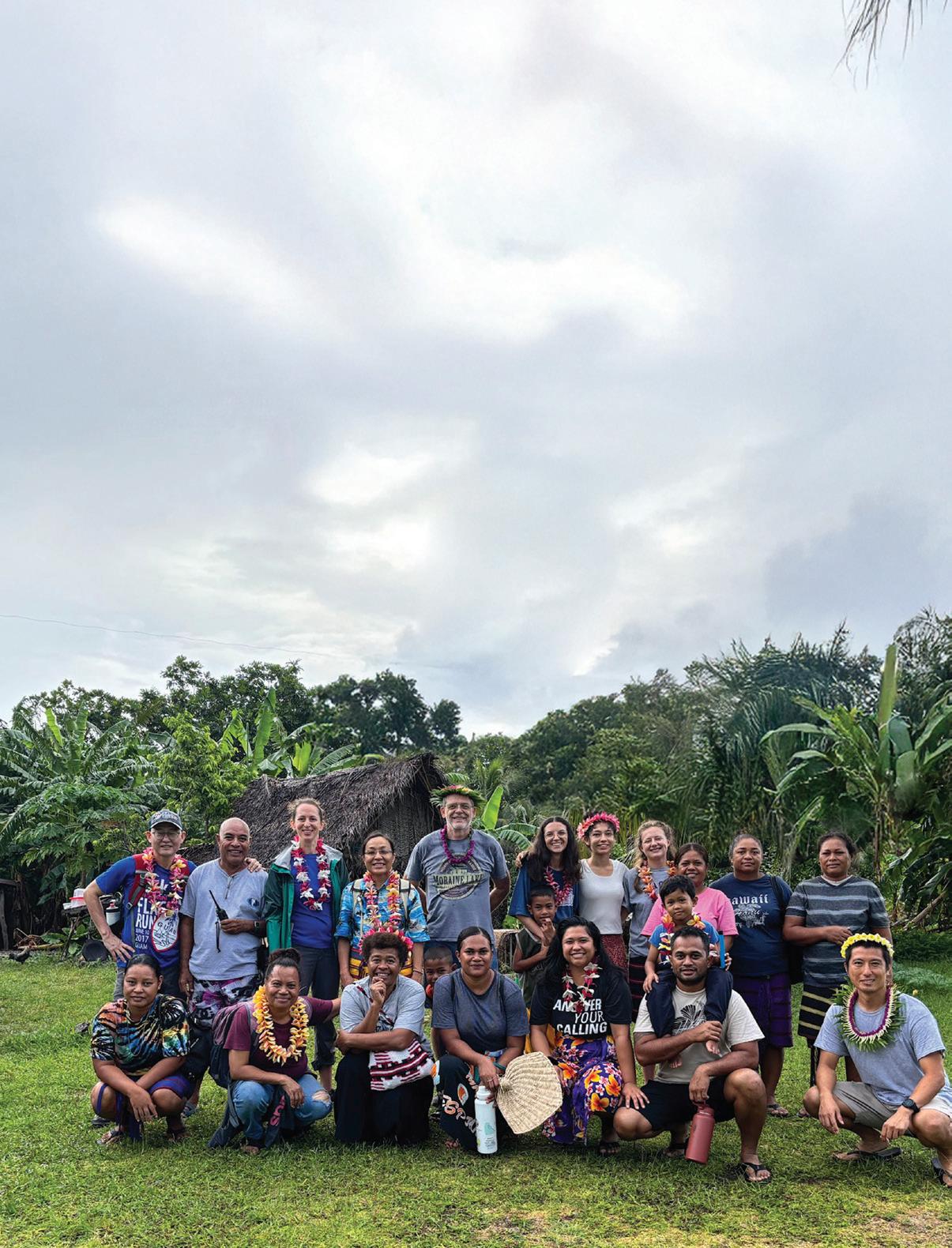
The fruit of three decades of work on a small island
Shin Miyagi
the Lord has led in the past truly motivates faith for future plans.
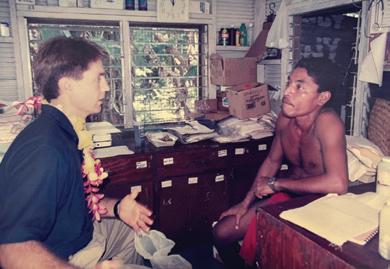

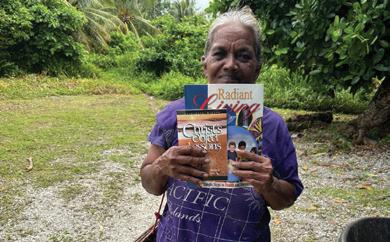


Fais is a remote island in Yap State, Micronesia. This small island, home to about 294 residents,* is rich in traditional culture, relying on fishing, coconuts, gardening, and other local resources. Until recently its residents were traditionally clothed with lava lavas (hand-woven wraparound sarongs) on bare-breasted women and thu’u-wrapped men. Communication with neighboring islands is via walkie-talkie since there are neither cellular nor internet services. There is also no running water in the homes, and cooking is done over an open fire.
Through the years several Adventist medical missionaries have visited Fais, beginning with Dr. Wayne Ward, a dentist from the Guam Seventh-day Adventist Clinic, and Dr. Wes Youngberg, a lifestyle medicine specialist and nutritionist and wellness, in 1995. During their visit they met a young man named Alphonso, who was the sole medical provider in Fais at the time, but was also alcohol-dependent. Dr. Youngberg recalls sitting around the fire one night, talking with the chief and other island leaders, when he noticed Alphonso was asking many questions about the health consequences of common lifestyle choices on the island. After returning to Guam, Dr. Youngberg wrote a letter to Alphonso that Alphonso says changed his life. In the letter Dr. Youngberg suggested that as a health professional on the island, Alphonso was looked up to and respected, and as such he should abstain from alcohol and become a better role model for health and spiritual leadership. Alphonso came to be convicted of this truth and surrendered the alcohol habit completely.
Alphonso eventually started a nondenominational church on the small island, which had been predominantly Catholic for generations. The growing group would meet daily for morning Bible study and then go out and provide community service where needed. Faith in action was the catalyst that grew the original Bible study group into the small church that Alphonso pastors today.
In 2008-2009 a missionary couple, Dmitry and Grace Lossev, traveled to Fais multiple times, and presented the Sabbath message. According to Dmitry, Alphonso and several elders seemed to be under the conviction to accept the Sabbath message, but most of the women and the rest of the church members were not sure, and ultimately decided not to start worshipping on Saturday.
In October 2024, after several years of no contact, a team of health-care providers from the Guam Seventh-day Adventist Clinic finally returned to the island of Fais, working together with Pastor Wanes of the Yap Seventh-day Adventist Church and their women’s ministry team to reconnect and serve the people of Fais. Together they assembled a team consisting of a pastor, a medical doctor, an optometrist, a dentist, physician assistants, women from the women’s ministry, and missionary teachers from Yap Seventh-day Adventist School.
Less than a day before the clinic team was scheduled to depart for Fais, their medical equipment was still being held by Yap customs. The island’s customs division is known for sometimes holding on to shipped items for prolonged periods—even up to several months! The team began to question whether the plans they had made several months before needed to be canceled because of this unexpected turn of events. As doubts began to surface, the team quickly remembered the miracles God had already orchestrated to establish their faith and increase their understanding of the importance of this visit.
In preparation for the visit, the island chief had given his much-needed permission and blessing to the clinic team to hold spiritual meetings for the first time. The importance of this type of permission should not be understated. In tribal island culture no meetings, and especially spiritual meetings, may be held without the chief’s permission. Not only is this permission important and required for any visiting group, but it is equally required in order for the local people to participate. Having the chief’s blessing was vital to the success of the clinic’s planned outreach. Remembering how the Lord has led in the past truly motivates faith for future plans.
After reflecting on the miracles God had worked during the preparation for the mission trip, the team made it a priority to spend time in diligent prayer, exercising patience and calling upon God’s grace to solve the crisis at customs. God answered their prayers, and the medical equipment and medications were finally released—just in the nick of time!
The familiar words of the song “I Have Decided to Follow Jesus” cut through the darkness, and the Holy Spirit’s presence was palpable.
When we finally arrived at Fais, the islanders were excited to see our group, and among them was Pastor Alphonso. They greeted us with traditional fresh flower leis, and took the medical equipment, supplies, and luggage in wheelbarrows, transporting them to the worksite as fast as they could while the team prepared for the clinics. Preparations were made for medical, dental, and optometry clinics, and home visits were also arranged for those unable to physically come to the erected clinic sites.
The team also focused on lifestyle education since medications are scarce because of infrequent shipments to the island. Healthy cooking classes, using lentils and local vegetables, which were planned for the women of the island, also saw men attending as well! In the evenings health presentations, children’s programs, and evangelistic meetings were held. Each night the meetings drew more attendees, especially children, thanks to engaging programs led by the missionary teachers.
The blessing of the Sabbath was addressed on the fourth night of the evangelistic meetings, receiving an unexpectedly positive response from the nondenominational church members. Before the final meeting, Pastor Alphonso shared that his church’s core members had
discussed and decided to keep the Sabbath on Saturday rather than on Sunday and asked for prayers in their commitment to follow biblical truth.
Despite a power outage midway through the final night of the evangelistic meetings, many affirmed their commitment to serve and follow Jesus. The familiar words of the song “I Have Decided to Follow Jesus” cut through the darkness, and the Holy Spirit’s presence was palpable. Tears flowed as people stood in response to the appeal concluding the series of evangelistic meetings and the culmination of the mission to Fais.
Over the course of more than three decades, the Holy Spirit had been working in the hearts of Fais Island residents, leading up to the decisions to keep the seventh-day Sabbath holy. Pastor Alphonso later wrote: “I have been serving the Lord with all my heart these past years, and now He is going to do more when we surrender all to Him. He used you to touch my heart and lead me to His Word, to follow it and not people. We have been observing the Sabbath on Saturday instead of Sunday. Praise God, and may God bless you.”
Pastor Alphonso and his church continued to study the Bible with sincere hearts, and through the loving guidance and repeated visits from the Yap Adventist Church pastor, a beautiful transformation took place. In July 2025 Pastor Alphonso, along with many of his church members, joyfully gave their lives to Jesus in baptism—a powerful testimony to the quiet yet mighty work of the Holy Spirit.
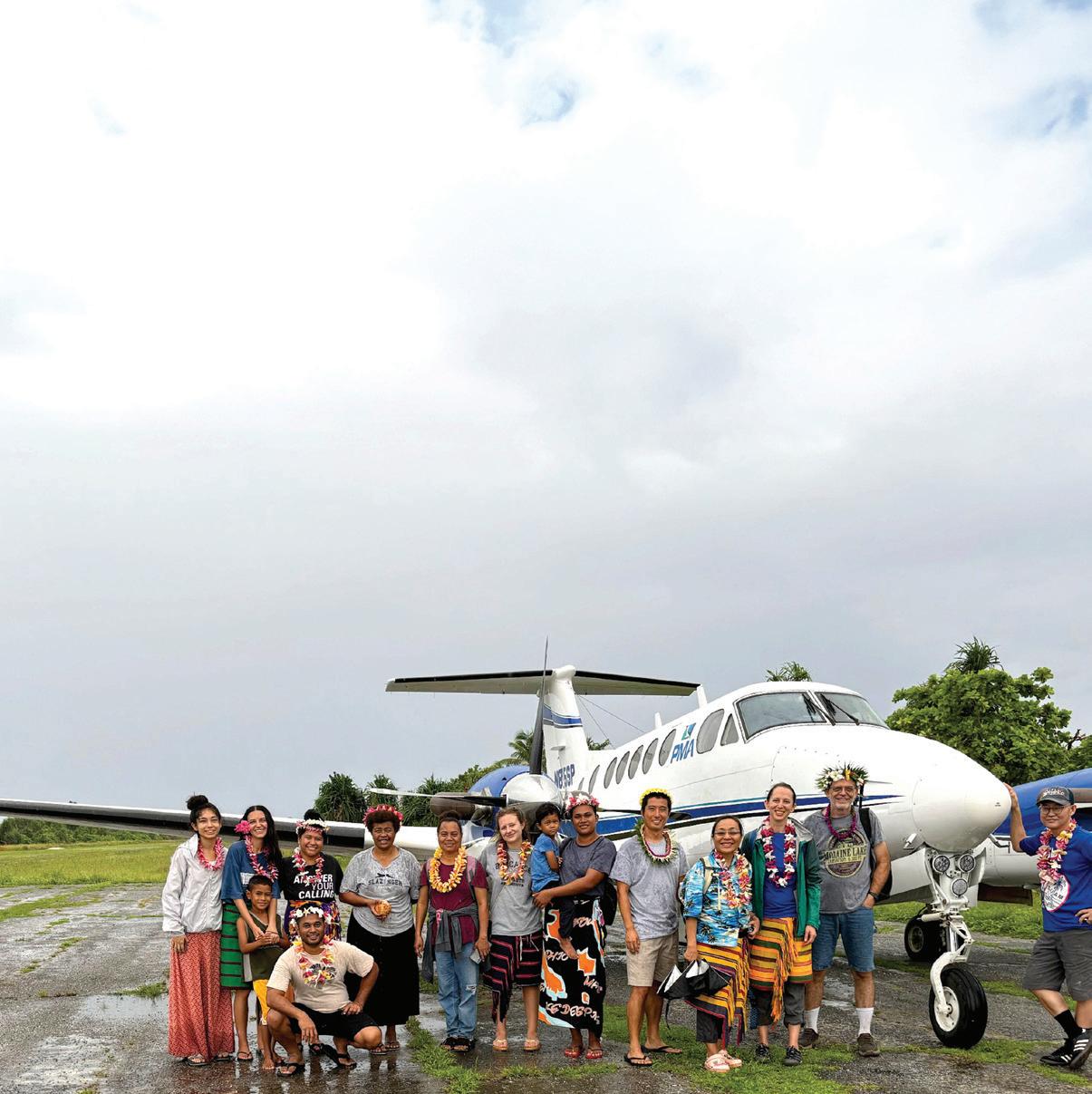
The Lord is indeed working to draw people closer to Him, and He works through us to reach these precious souls. The gospel commission calls us to go to the ends of the earth, and Fais is but one island of many in need of the gospel. A tiny little-known island that may appear insignificant by human estimation has not missed the notice of the omnipotent God. On Fais, medical ministry provided an opening wedge to minister to spiritual needs that the Holy Spirit was ripening for years in advance. There are many more unreached islands such as Fais, and we need more workers, support, and prayers for discernment. “The harvest truly is plentiful, but the laborers are few. Therefore pray the Lord of the harvest to send out laborers into His harvest” (Matt. 9:37, 38). Will you not answer the call?
* FSM National Government, Department of Resources and Development, Statistics Division, Yap-Basic-Tabulation-2010-Census-of-Population-and-Housing. https://stats.gov.fm/states/yap/. Accessed July 30, 2025.
Shin Miyagi is a family medicine physician serving at the Guam Seventh-day Adventist Clinic.

In the final judgment, will God take the life of the wicked by force?
isuppose you are interested in God’s fairness or justice when the destruction of the wicked and the evil forces occurs. In the context of the cosmic conflict, this is an important concern because it determines whether the conflict will come to its resolution. A brief review of the judgment could be useful in answering your question.
Any crime alters the social order of any society and would require the use of a legal process to reestablish it. One can only imagine the magnitude of the impact of the crime committed by a cherub that rebelled against the government of God (Isa. 14:12-14). It certainly impacted every one of God’s creatures across the whole cosmos. Restoring the original order established by God at creation would be an immense challenge that would require the use of an infallible legal system, one that reveals in an absolute and unquestionable form the truth of what happened. It should be powerful enough to bring the conflict to an end in a righteous and loving manner.
After an evil action is committed, the evidence supporting the accusation has to be gathered, investigated, and analyzed (e.g., Gen. 3:8-13; Hosea 4:1, 2). The investigation attempts to show that the accusation is valid and that, in the search for justice and
the restoration of peace, someone should be charged for the crime; the culprit must be clearly identified. The Bible emphasizes this aspect of the judicial proceedings by referring to heavenly books containing the deeds of human beings (Dan. 7:9, 10; Rev. 20:12) and by stressing that in the divine tribunal humans will be judged by those deeds (Matt. 12:36, 37; Rev. 20:13). It is an intensive cosmic search and analysis that will demonstrate that those charged with the crime are indeed guilty. This investigation and analysis is done in the presence of heavenly beings, who, as witnesses, are allowed to look at the judicial proceedings under the personal direction of God and His Son (Dan 7:9, 10, 13; John 5:22). The investigation and the analysis of the evidence will be so thorough that all of God’s loyal creatures will acknowledge the integrity of the process and the reliability of God’s justice.
Once the evidence is investigated and analyzed, the divine tribunal will pronounce a final verdict—guilty or not guilty. There are two components related to this aspect of the final judgment of the wicked that I would like to mention. First, the verdict is not negotiable. There is not a cosmic court of appeal for the wicked. It is to be enforced, no matter what, during the executive judgment (Rev. 20:9). Yes, God—the giver of life—will bring their lives
to an end. Second, the divine intention is to restore cosmic peace and order through the final verdict. It is at this point in the judicial proceedings that the figure of Christ and His infinite sacrifice rises above the immense crowd of the wicked and appears to them as the Lamb that was slain (Rev. 14:10). He is God’s Faithful Witness, who unfurls before them the cross as unquestionable evidence of God’s infinite love and justice. Nothing else is needed to persuade the wicked and the forces of evil that God is—and has always been—a God of love and justice (Phil. 2:10, 11; Rev. 5:1113), and that they deserve to die. God will then take their lives as fire descends from Him and consumes them (Rev. 20:9). At this junction in cosmic history, the conflict will be peacefully over.
Ángel Manuel Rodríguez, Th.D., is retired after a career serving as pastor, professor, and theologian.

the summer youth pastor was assigned to lead more than 100 teenagers in Phoenix, Arizona. He found an old barn and opened it for “food and fun” on Friday evenings. The teens came, brought their guitars, and ate the burgers. Lots of burgers.
The music began early and lasted till late. One evening a guy asked, “Can you learn about grace in the Old Testament, or is that just in the New Testament?”
The youth pastor opened the Old Testament and started telling grace-filled Bible stories. The next three Friday nights were filled with laughing, singing, praying, and talking about the God of grace.
Then Timmy spoke up.
“I think we’re being really selfish,” he declared. “I mean, we’re not sharing any of our food and music and fun with anyone else! Isn’t grace better when we share it with others? We’ve only been thinking about us. Maybe we ought to share with somebody else!”
That began an intense discussion about practical Christian living. At the end of the evening Timmy gave everyone an assignment.
“Come back next Friday night with one good idea about something grace-filled we could do for someone else.”
Timmy spoke first the next Friday evening. “I’ve found an 85-year-old Indian woman on the Fort McDowell Indian reservation who actually translated for Elder H.M.S. Richards during one of his evangelistic campaigns. She lives in an ancient adobe house with no running water. I think we ought to build her a new house.”
Everyone agreed, as if they were professional contractors.
Nellie Quail’s house was a crumbling adobe with one small room that was cluttered with a bed, a small dresser, a weaving loom, and a stack of cooking pots. The kitchen was outside, and the bathroom was “down the creek a bit.”
Nellie was a bent-over grandma who peered at Timmy and the youth pastor with amazed displeasure.
“I like my house. Why would I want a new one?”
Friday night Timmy showed everyone pictures of Nellie and her house. “The new house should be bigger than this one,” he said. Then he started giving out assignments.
“We’ll need drywall, paint, shingles, and a stove,” he began.
“And an indoor toilet,” someone interrupted. “And a refrigerator, a bathtub, and a new bed with sheets,” others shouted.
The list grew rapidly, and so did the list of teens who were willing to find the things they’d need.
The youth pastor was assigned to design the house. He quickly visited a local plumber who offered to draw the plans.
“Yes. Please. And thank you,” the youth pastor smiled. “I’ll put the plumbing together, but the kids will have to dig the foundation. Once you do the digging, you’ll need seven yards of concrete for the foundation.”
The next Friday evening the plumber, Timmy, and the youth pastor distributed a new, longer list of construction materials.
“OK,” Timmy said. “Let’s go around town and beg businesses to give us all this stuff.
“If God wants Nellie to have a new house, He’ll help us get the materials.”
After singing and burgers, Timmy divided everyone into teams, making sure each person had a begging list.
At 7:00 a.m. Sunday morning the youth pastor loaded 12 teenagers into a big work truck and headed for Nellie’s new house. The plumber had arrived early and was just finishing staking out the foundation.
By noon they were exhausted and hot, and nowhere near done digging the foundation! The youth pastor gave everyone an inflated inner tube and threw them into the Verde River to float back toward town while he drove to Phoenix and picked up another 14 teens for the afternoon shift.
“Remember,” Timmy told everyone, “God’s getting us seven yards of concrete. He’s got a full truckload on the way!”
Groups of teens took the request to all the concrete companies around Phoenix. Each said “No!” And the kids came back discouraged.
“It’s OK,” Timmy said. “We don’t need the concrete for two more weeks. God will be on time.”
Everyone prayed. But no concrete came.
On Friday afternoon before the Sunday concrete deadline, Timmy and the youth pastor were driving on a back road near Phoenix.
“What are we going do about the concrete?” the youth pastor asked.
“Where’s your faith, Pastor? We’ve done all God’s asked. Now it’s up to Him. Right?” “Right.”
“Then,” Timmy added, “let’s follow the next concrete truck we see on the road.” “Right.”
Five minutes later a concrete truck pulled onto the road in front of them.
Timmy smiled the kind of smile you smile when you see a prayer answered.
The truck turned right and disappeared behind a tall sand dune. They stayed with it, around the dune, through a twisty arroyo, over a hill, until it stopped in the yard of a small concrete company.
Timmy was there before the truck stopped. The driver, an older man with shoulder-length hair, looked down at Timmy, who was already talking.
“Hello, sir. I’m Timmy, and a bunch of us teenagers are building a house for an 85-year-old Indian woman who lives on the Fort McDowell Indian reservation. She hasn’t ever had water in her house, and we’re going to put water in her house, and she’s going to have electricity, and she’s never had electricity or anything nice like that. We’ve dug the foundation and laid out the plumbing, but we need seven yards of concrete for the foundation, and God has sent us to you so you can supply the concrete for Nellie Quail’s new house.”
The driver motioned for Timmy to be quiet and looked over at the youth pastor.
“Is this kid for real?”
“Yes, sir.”
The man dismounted, looked at Timmy, and said, “All right, son. Tell me again. This time, talk slower.”
While Timmy was rapidly repeating everything he knew about Nellie and her house, he also drew a map in the dirt on the truck’s front door.
“You’ll need to be there at 6:00 a.m. Sunday morning, sir.”
“Can’t do 6:00.” The man paused to kick some dirt off his boots. “But I can be there at 7:00. OK?”
“Sure. That’ll do.”
Then the man looked back at Timmy and asked, “Will anyone out there know what to do with the concrete?”
Timmy pointed to the youth pastor. “He’s the guy.”
“OK,” said God’s concrete man, glancing at his door map. “See you at 7:00 Sunday morning. Now get out of here. I’ve got work to do.”
Friday night Timmy told the story, and everybody joined in a celebration prayer session that must have made the angels cry.

Sunday morning at 5:00 a.m. 20 teenagers piled into the old work truck. They had five shovels, a collection of rusty trowels, and a couple hammers. The kids were not ready, but they pretended, and hoped.
6:45 a.m.: no truck. 7:00 a.m.: no truck. 7:06 a.m.: “Rumble. Rumble. Honk!”
Everyone stood. Faces pointed down the road like a flock of geese.
A huge cloud of dust announced a big white concrete mixer truck, with a map drawn on its dusty door.
“Sorry I’m late. Messed up on the map. Ready to work?”
He had brought enough concrete tools to make everyone feel valuable. Nellie watched, her eyes blurred with tears, as the kids poured, leveled, and put handprints in the concrete.
Forty-five minutes later God’s concrete man washed out his truck and came over to the kids. Tears poured down his dirtstreaked face.
“I’ve done lots of stuff in my life,” he began, “but this is the only thing I’ve ever done that made any sense. I’ve always done things for me. This is the first time I’ve done something for somebody else, and for free! It’s also the first time I’ve ever done anything for God. I feel like a new person!”
He hugged the youth pastor. He hugged Timmy. Then he hugged everybody except Nellie, who was crying beside her adobe. Then he climbed into his truck, blew the horn a dozen times, and rumbled off down the road.
How resistance training boosts health, mobility, and longevity.
Question: I walk regularly and briskly, but my doctor is concerned about possible decreasing muscle strength as I age. Should I walk more?
Answer: Your doctor is correct. Aerobic exercise is not enough; intentional resistance exercise is essential for health and well-being across the life cycle. Muscle strength and resistance training are essential components of lifelong health and longevity. Scientific evidence increasingly demonstrates that maintaining and improving muscle mass and function not only supports mobility and independence but also plays a critical role in preventing chronic diseases, improving metabolic health, and extending lifespan. In childhood and adolescence, building muscle strength lays the foundation for lifelong health. Resistance activities—including play, climbing, and sports—enhance bone density, promote healthy weight, and support the development of coordination and balance. The World Health Organization (WHO) recommends that children and adolescents engage in muscle-strengthening activities at least three times per week. Youth with higher muscular fitness have a lower risk of obesity, cardiovascular disease markers, and insulin resistance later in life.
and reduces visceral fat, making it a key nonpharmacologic intervention in preventing type 2 diabetes and metabolic syndrome. Even modest resistance training—less than an hour per week—has been associated with a 40 to 70 percent reduction in risk of cardiovascular disease.
Muscle mass assists in regulating inflammatory cytokines and plays a part in hormonal balance. Resistance training has been shown to reduce depression and anxiety symptoms and improve sleep quality, making it beneficial for both mental and physical well-being.
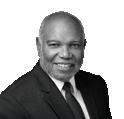
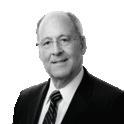
90s. Careful scientific observation has demonstrated that institutionalized frail elders experienced significant improvements in muscle strength and walking speed after just eight weeks of high-intensity resistance training.
Muscle strength and resistance training are essential components of lifelong health and longevity.
As individuals age, the natural decline in muscle mass and strength, or sarcopenia, becomes a major health concern. Sarcopenia leads to increased risk of falls, fractures, loss of independence, and premature mortality. Studies show that muscle strength is a stronger predictor of mortality than even blood pressure or BMI in older adults.
Strength training is associated with a reduced risk of mortality. Individuals who engage in strength training at least twice per week have a significantly lower risk of premature death and a lower risk of cancer-related death. These benefits are independent of aerobic physical activity, highlighting the unique contribution of resistance training. Resistance training is vital in building bone density in youth to combat sarcopenia across the human lifespan. The benefits of muscle strength extend beyond aesthetics or athleticism—they are deeply tied to the preservation of metabolic health, function, and longevity. And yes—continue walking!
We would do well to daily exercise both our faith and our muscles to enjoy wholistic health and well-being in the Lord (Joshua 1:7-9).
In adults muscle strength plays a major role in metabolic and cardiovascular health. Regular resistance training improves insulin sensitivity, aids in blood glucose control,
Resistance training is the most effective intervention to counteract sarcopenia. Older adults participating in progressive resistance training (PRT) may experience significant gains in muscle mass, strength, and functional mobility. Resistance training is effective even in individuals in their 80s and
Zeno L. Charles-Marcel, a board-certified internist, is the director of Adventist Health Ministries at the General Conference. Peter N. Landless, a board-certified nuclear cardiologist and General Conference Adventist Health Ministries director emeritus, is also a boardcertified internist.
Erton Köhler
iwant to begin this first message by sincerely thanking each of you who sent words of encouragement, shared thoughtful counsel, and (most important) lifted me and my family up in prayer following my election last July. Your support has upheld us, and your faith has strengthened us. We are deeply grateful.
As we begin this new journey, I believe God is calling us to move forward grounded in the Bible and focused on the mission. These are not just meaningful words—they are convictions that must shape everything we do as a church.
This vision is described in Isaiah 37:31, where the prophet declares, “And the remnant who have escaped . . . shall again take root downward, and bear fruit upward.” This is a call not only to Judah but also to God’s end-time remnant church. The roots downward represent our foundation in Scripture—the source of truth, our identity, and spiritual strength. The “fruit upward” represents the global mission we’ve been given: to proclaim the everlasting gospel to a world in need.
If the roots are strong, the fruit will be abundant. But no roots, no fruits. No identity, no mission. When we are firmly grounded in the Bible—with love, clarity,
and conviction—we will be fully focused on the mission, and the Spirit will lead us to bear fruit for the kingdom.
Ellen G. White reminds us, “The more our thoughts are upon Christ, the more we shall speak of Him to others and represent Him to the world.”*
A strong biblical identity naturally leads to faithful witness. Those who walk with Christ will speak of Christ.
This is who we are as Seventh-day Adventists—people of the Book, grounded in God’s Word, and committed to Christ’s mission.
So let us move forward grounded in the Bible and focused on the mission, united in purpose, and fully dependent on the Holy Spirit. The harvest is ready. The time is now.
I Will Go. Will you?
Erton
PUBLISHING BOARD
Ted N. C.
;
Biaggi, vice chair; Justin Kim, secretary; Audrey Andersson, G. Alexander Bryant, Zeno CharlesMarcel, Williams Costa, Paul H. Douglas, Mark A. Finley, James Howard, Erton Köhler, Geoffrey Mbwana, Magdiel Perez Schultz, Artur Stele, Ray Wahlen, Karnik Doukmetzian, legal advisor
MANAGEMENT BOARD BASED IN SEOUL, KOREA Yo Han Kim, chair; Justin Kim, secretary; Karnik Doukmetzian; SeongJun Byun; Hiroshi Yamaji; Tae Seung Kim; Ray Wahlen; Ex-officio: Paul H. Douglas; Erton Köhler; Ted N. C. Wilson
EDITOR Justin Kim
ASSOCIATE EDITORS Shawn Boonstra, Sikhululekile Daco
ASSOCIATE DIRECTOR Greg Scott
COMMUNICATION DIRECTOR/NEWS EDITOR Enno Müller
ASSISTANT EDITORS Beth Thomas, Jonathan Walter
EDITORS BASED IN SEOUL, KOREA Jae Man Park, Hyo-Jun Kim, SeongJun Byun
FINANCE MANAGER Kimberly Brown
DIRECTOR OF SYSTEMS INTEGRATION AND INNOVATION Daniel Bruneau
ART DIRECTION AND DESIGN Brett Meliti, Ellen Musselman, Ivan Ruiz-Knott/Types & Symbols
LAYOUT TECHNICIAN Fred Wuerstlin
COPY EDITOR James Cavil
OPERATIONS MANAGER Merle Poirier
EDITORIAL ASSESSMENT COORDINATOR Marvene Thorpe-Baptiste
SENIOR ADVISOR E. Edward Zinke
AD SALES Glen Gohlke
DISTRIBUTION Sharon Tennyson
WEBSITE: www.adventistreview.org
TO WRITERS: Writer’s guidelines are available at www.adventistreview.org at the footer. For further correspondence, email manuscripts@adventistreview.org
Unless otherwise noted, Bible texts in this issue are from the New King James Version. Copyright © 1979, 1980, 1982 by Thomas Nelson, Inc. All rights reserved. Bible texts credited to NIV are from the Holy Bible, New International Version. Copyright © 1973, 1978, 1984, 2011 by Biblica, Inc. Bible texts credited to NRSV are from the New Revised Standard Version of the Bible, copyright © 1989 by the Division of Christian Education of the National Council of the Churches of Christ in the U.S.A. Used by permission. All rights reserved worldwide. Scripture quotations marked ESV are from The Holy Bible, English Standard Version® (ESV®) © 2001 by Crossway, a publishing ministry of Good News Publishers. All rights reserved. ESV Text Edition: 2016. Scripture quotations marked NASB are from the New American Standard Bible, copyright © 1960, 1971, 1977, 1995, 2020 by The Lockman Foundation. All rights reserved.
The Adventist Review (ISSN 0161-1119) is the general paper of the Seventh-day Adventist® church. It is printed simultaneously around the world in Argentina, Australia, Austria, Brazil, Germany, Indonesia, Korea, South Africa, and the United States. It is published monthly by the General Conference of Seventhday Adventists®, 12501 Old Columbia Pike, Silver Spring, MD 20904, U.S.A. The Korean editorial and business offices are located at the Northern Asia-Pacific Division, 67-20 Beonttwigigil, Paju-si, Gyeonggi-do 10909, Republic of Korea.
Copyright © 2025, General Conference of Seventh-day Adventists®. Vol. 202, No. 18



